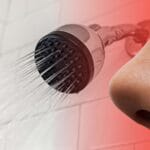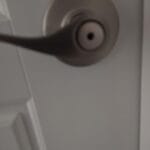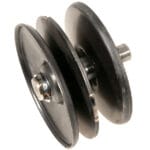Picture this: you’re in a hurry, and suddenly, you find yourself locked out of your bathroom. Frustrating, right?
We’ve all been there. That sinking feeling when the door just won’t budge can be overwhelming. But don’t worry! You’re not alone in this, and there are simple solutions to get that door open without causing damage. In this guide, you’ll discover easy and effective techniques to regain access to your bathroom.
Whether it’s a pesky lock or a jammed door, we’ve got you covered. Keep reading, because by the end of this article, you’ll be equipped with the know-how to tackle this common problem effortlessly. Let’s turn that frustration into relief, and get you back on track with your day.
Common Lock Types
Opening a locked bathroom door often involves understanding common lock types. Most bathroom doors use simple twist locks or push-button locks. A thin tool, like a butter knife or credit card, can sometimes help open these locks easily.
Understanding the common types of locks you may encounter on a bathroom door can save you time and frustration. Each lock type has its unique mechanism and requires a different approach to open. Knowing these differences can help you choose the right method quickly and efficiently.Push Button Locks
Push button locks are among the most common types found on bathroom doors. They are simple and user-friendly, making them a popular choice in many homes. Have you ever pushed that small button on the knob, only to realize later that you’ve locked yourself out? If you find yourself facing a locked bathroom door with a push button lock, a thin, flat object like a credit card or a butter knife can be your best friend. Gently slide it between the door and the frame to disengage the lock. Sometimes, these locks come with a small hole on the outside knob. A straightened paperclip inserted into the hole can release the lock easily.Twist Locks
Twist locks add a slight twist—pun intended—to the locking mechanism. These involve a small knob that you turn to lock and unlock the door. It’s one of those locks you might absentmindedly twist as you exit, only to hear a click behind you. If you need to open a twist lock from the outside, try using a bobby pin or a small screwdriver. Insert the tool into the small hole on the doorknob and turn it slowly. Did you know that some twist locks can be opened by simply turning the outside knob with a bit more force? This is because they’re designed to unlock easily in case of emergencies.Keyhole Locks
Keyhole locks are typically found in more formal settings, like office buildings or guest bathrooms. They require a key to operate, which can be both a blessing and a curse. Losing the key can leave you feeling helpless. If you’ve misplaced the key, a lock pick set can be useful, but it requires some skill and patience. Alternatively, you can try using a small, flathead screwdriver. A handy tip is to keep a spare key in a secure, yet accessible place to avoid this predicament. Have you ever thought about hiding a spare key in a magnetic box under the bathroom sink? Understanding these common lock types can prepare you for unexpected situations. It’s always good to be a step ahead and have a few tricks up your sleeve. How do you handle a locked bathroom door? Share your tips in the comments!
Credit: www.youtube.com
Tools You Might Need
Encountering a locked bathroom door can be frustrating. But before calling a locksmith, try some simple tools. These everyday items might help you gain access quickly. Let’s explore what you might need to tackle this problem.
Flathead Screwdriver
A flathead screwdriver is a handy tool. It fits into the slot of many bathroom locks. Insert the screwdriver into the slot. Turn it gently to open the lock. Be careful not to use too much force. This can damage the lock or the screwdriver.
Butter Knife
A butter knife is another household item you can use. Choose one with a thin, flat blade. Slide it into the crack between the door and the frame. Wiggle it around until you feel the lock release. It’s a simple and effective method for many doors.
Bobby Pin
Bobby pins are great for picking locks. Bend one end to create a small hook. Insert it into the lock’s keyhole. Feel for the pins inside and try to push them up. With patience, you can unlock the door. Practice makes this process easier.
Credit Card
Credit cards are flexible and can slide into tight spaces. Use an old card you don’t mind damaging. Slide it into the space between the door and frame. Push and wiggle the card against the latch. This can push the latch back, freeing the lock.
Using A Flathead Screwdriver
Need to open a locked bathroom door? Try using a flathead screwdriver. Insert it into the slot on the doorknob, turning gently. This method is helpful for simple privacy locks, offering a quick solution without damage.
Have you ever found yourself locked out of the bathroom with no key in sight? It’s a frustrating situation, but fear not! A flathead screwdriver might be your unexpected hero. This simple tool can help you regain access without calling a locksmith. A flathead screwdriver is commonly found in most households. Its slim design makes it perfect for unlocking certain types of bathroom door locks. Let’s explore how you can use this tool for different lock types.For Push Button Locks
Push button locks are straightforward. They are often found in residential bathrooms. If your door has a small hole in the center of the doorknob, you’re dealing with a push button lock. To unlock it, insert the flathead screwdriver into the hole. Gently press until you hear a click. This click indicates that the button inside has been pushed, releasing the lock. It’s a simple trick that can save you time and hassle. Next time you find yourself locked out, remember the trusty flathead screwdriver might be all you need.For Twist Locks
Twist locks are a bit different and slightly more challenging. They require you to turn the lock mechanism. If your doorknob has a hole on the side, you likely have a twist lock. Insert the flathead screwdriver into the hole. Apply gentle pressure and turn the screwdriver in the direction you would normally twist the lock. Feel the mechanism moving? You’re on the right track! This technique requires a bit more finesse and patience. Have you tried this before? Did it work for you? Using a flathead screwdriver can be surprisingly effective. It’s a handy trick that proves you don’t always need specialized tools. Just remember, this technique is meant for interior locks, not for breaking into spaces where you don’t belong!
Credit: www.reddit.com
Applying A Credit Card Technique
Applying a credit card technique can be a simple solution for opening a locked bathroom door. This method uses a common household item, making it accessible and convenient. It’s useful in situations where keys are misplaced or unavailable. Using a card is less invasive, preserving the door’s integrity and avoiding damage.
Ideal Situations For Use
Not every lock responds well to a credit card. This technique works best with spring bolt locks. These locks have a slanted latch, allowing the card to slide in and push it open. Bathroom doors often have this type of lock. Avoid this method on deadbolt locks, as it won’t work. Ensure the door has a small gap. The card needs space to maneuver.
Step-by-step Guide
First, select a flexible card. A store card or old credit card works well. Avoid using important cards. They could bend or break during the process.
Next, insert the card between the door and frame. Aim for the area above the lock. Angle the card towards the latch. Press firmly to slide it in.
Once the card is in place, bend it back. This helps push the latch away from the strike plate. Wiggle and push the card while turning the door knob. The door should pop open.
If the door remains locked, adjust your angle. Try again with a different card thickness. Repeat until successful. With patience, this technique often works. Always exercise caution to avoid damage.
Unlocking With A Bobby Pin
Got a locked bathroom door? Try a bobby pin to open it. Bend the pin into a hook shape. Slide it into the keyhole and gently wiggle. This technique often works for basic locks, offering a simple solution to an annoying problem.
Always be careful not to damage the door or lock.
Unlocking a locked bathroom door with a bobby pin can be handy. It’s a simple technique that doesn’t require special tools. A bobby pin is small and easy to find. It can help you regain access quickly. Here’s how to use it effectively.Preparing The Bobby Pin
Start by finding a sturdy bobby pin. Bend it to make a straight piece. Remove any plastic tips. This ensures it fits inside the lock. Make a small L-shape at one end. This helps in turning the lock.Picking The Lock
Insert the straight end into the keyhole. Push it gently to feel the pins inside. Wiggle the bobby pin up and down. This action lifts the lock pins. Apply slight pressure with the L-shaped end. Turn it like a key. Listen for a click. That means the door is unlocked. If it doesn’t work, try again. Patience is key. Using a bobby pin is effective for simple locks. Always be gentle to avoid damage.Using A Butter Knife
Locked out of a bathroom? A butter knife might just help. It’s a common household tool, often underestimated. But it can unlock doors in a pinch. Knowing how to use it effectively is key. Let’s explore how to tackle different lock types with a butter knife.
For Push Button Locks
Push button locks are quite simple. First, find the small hole on the doorknob. Insert the butter knife into the hole. Apply gentle pressure. Feel around for a button inside. Once you feel it, push. The lock should release. Try to be gentle. Too much force might damage the lock.
For Twist Locks
Twist locks need a bit more finesse. Slide the butter knife between the door and the frame. Locate the latch inside. It’s usually near the edge of the door. Wiggle the knife to nudge the latch. This should slide the lock open. Patience is crucial here. Move slowly to avoid damage.
When To Call A Locksmith
Facing a locked bathroom door can be frustrating. Call a locksmith if you’re unable to open it safely. Their expertise ensures your door is opened without damage, saving time and stress.
When you find yourself locked out of your bathroom, calling a locksmith isn’t always your first thought. Often, you might try a few DIY methods first. However, there are situations where professional help is not just a convenience but a necessity. Knowing when to call a locksmith can save you time, money, and prevent further damage to your door. Let’s explore the critical signs that indicate you need an expert’s touch.Signs Of A Complex Lock
If your bathroom door is equipped with a high-security lock, it’s better to call a locksmith. These locks are designed to be tamper-proof and more challenging to pick. Have you tried multiple unlocking methods without success? This might mean the lock is more intricate than it appears. Consider also whether you hear unusual sounds, like clicking or grinding. These can indicate internal issues that require professional tools and expertise.Avoiding Damage
Attempting to force your way into a locked bathroom can cause significant damage. A screwdriver might seem harmless, but it can scratch or dent the door. Did you know that using the wrong technique could break the lock entirely? Repairing or replacing a door lock can be costly. Think about how a locksmith has the right tools to open your door smoothly, minimizing any risk of damage. Wouldn’t you rather spend a bit on professional help than face a hefty repair bill later? By knowing when to call a locksmith, you not only solve the problem quickly but also protect your property.
Credit: www.youtube.com
Safety Precautions
Ensure safety by using tools gently to open a locked bathroom door. Avoid force to prevent damage or injury. Always prioritize personal safety and handle tools with care.
When you find yourself facing a locked bathroom door, it’s important to prioritize safety. While the urgency to solve the problem might tempt you to rush, taking a moment to consider safety precautions can prevent further issues. Whether you’re dealing with a simple lock or a more complex mechanism, these guidelines will help you handle the situation safely.Preventing Injury
Before you attempt any method to open the door, assess the tools you’ll be using. A butter knife or a credit card might seem harmless, but they can cause injury if not handled properly. Ensure you have a firm grip on the tool and use slow, controlled movements. This reduces the risk of slipping and injuring yourself or others around you. Consider wearing gloves if available. They provide extra grip and protect your hands from sharp edges or splinters, especially if you need to remove parts of the door.Maintaining Door Integrity
It’s easy to forget about the door itself when you’re in a hurry. But forcing the lock or using excessive pressure can damage the door, leading to costly repairs. Use gentle methods first. For instance, try pushing the door slightly while turning the handle. This might help realign the latch without causing damage. If you’re using a tool to pick the lock, apply minimal force. The goal is to manipulate the lock mechanism without bending or breaking it. Have you ever considered how much replacing a door costs? Maintaining door integrity not only saves money but ensures the door functions well for years to come.Frequently Asked Questions
How Can I Open A Locked Bathroom Door Without A Key?
Use a flathead screwdriver. Insert it into the keyhole. Twist gently to unlock.
What Tools Can Help Unlock A Bathroom Door?
Try a credit card, butter knife, or bobby pin. Insert and jiggle to unlock.
Are There Safety Concerns When Unlocking A Door?
Yes, avoid force. It may damage the door or lock. Be gentle.
Is Calling A Locksmith Necessary For A Locked Bathroom Door?
Only if other methods fail. Locksmiths are professionals. They can unlock without damage.
Can I Use A Wire Hanger To Unlock The Door?
Yes, straighten it. Insert into the lock. Twist to open gently.
Conclusion
Opening a locked bathroom door can seem tricky. But it doesn’t have to be. With the right tools and steps, you can solve this issue easily. Remember to stay calm and think clearly. Use a paperclip, bobby pin, or credit card if needed.
Always ensure safety first. Practice these methods if you can. This way, you’ll be prepared for future mishaps. Share these tips with friends or family. They might find them useful too. Remember, patience and practice are key. Keep calm, and you’ll handle any locked door like a pro.





